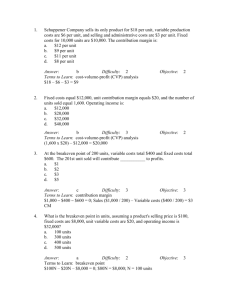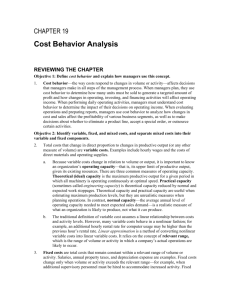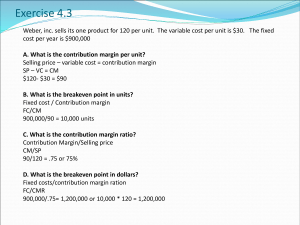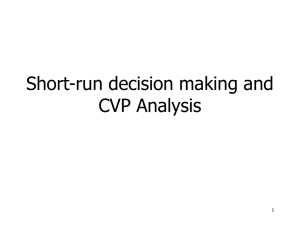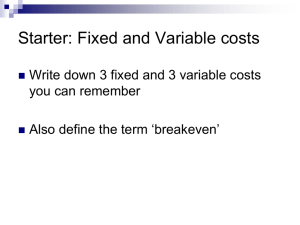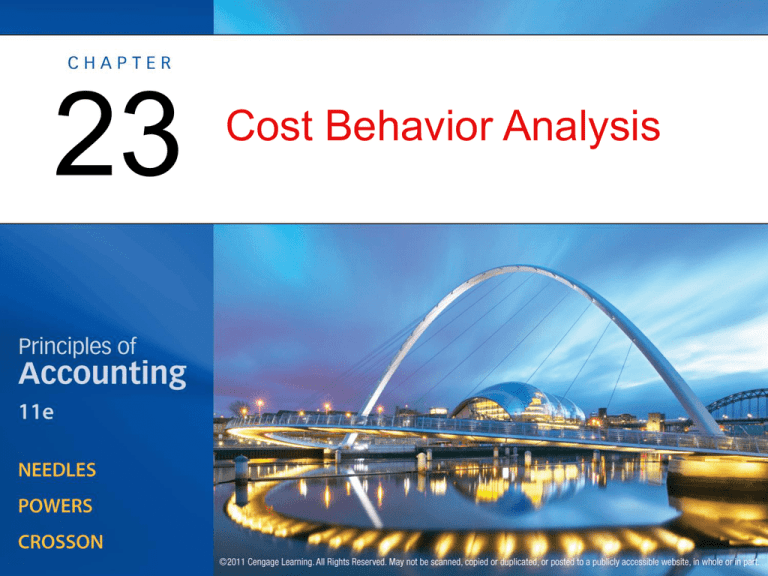
23
Cost Behavior Analysis
Cost Behavior and Management
OBJECTIVE 1: Define cost behavior, and
identify variable, fixed, and mixed costs.
Figure 1: A Common Variable Cost
Behavior Pattern: A Linear Relationship
Figure 2: Examples of Variable, Fixed, and
Mixed Costs
Figure 3: A Common Fixed Cost Behavior
Pattern
Figure 4: Behavior Patterns of Mixed
Costs
Figure 5: The Relevant Range and Linear
Approximation
Cost Behavior and Management
• Cost behavior refers to the way costs
respond to changes in volume or activity.
Cost Behavior and Management
• Managers use assumptions about cost
behavior in almost every decision they
make.
– When planning, managers use cost behavior to
determine how many units of products or
services must be sold to generate a targeted
amount of profit and how changes in planned
activities will affect operating income.
Cost Behavior and Management
• Managers use assumptions about cost
behavior in almost every decision they
make. (cont.)
– When performing their duties, managers use
cost behavior to determine the impact of their
decisions on operating income.
– When evaluating and reporting on
performance, managers analyze how changes
in costs and sales affect profitability.
Cost Behavior and Management
• The behavior of costs
– Total costs that change in direct proportion to
changes in productive output (or other volume
measures) are called variable costs.
– However, on a per unit basis, variable costs
remain constant as volume changes.
– Operating capacity is the upper limit of an
organization’s productive output capability,
given its existing resources.
Cost Behavior and Management
• The behavior of costs (cont.)
– There are three common measures of operating
capacity:
• Theoretical (ideal) capacity
• Practical capacity
• Normal capacity
Cost Behavior and Management
• The behavior of costs (cont.)
– The traditional definition of variable costs
assumes that a linear relationship exists
between costs and the measure of capacity
chosen.
– Many costs vary with operating activity in a
nonlinear fashion; this cost behavior can be
approximated within the relevant range using
linear approximation.
Cost Behavior and Management
• The behavior of costs (cont.)
– Fixed costs are total costs that remain constant
within a relevant range of volume or activity.
Fixed unit costs vary inversely with changes in
activity or volume.
– Mixed costs have both variable and fixed cost
components.
• Many mixed costs vary with operating activity in a
nonlinear fashion.
• Accountants use linear approximation to allow the
inclusion of nonlinear costs in cost behavior
analysis.
©2011 Cengage Learning All Rights Reserved. May not be scanned, copied or duplicated, or posted to a publicly accessible website, in whole or in part.
Mixed Costs and the Contribution Margin
Income Statement
OBJECTIVE 2: Separate mixed costs into
their variable and fixed components, and
prepare a contribution margin income
statement.
Figure 6: Scatter Diagram of Machine
Hours and Electricity Costs
Table 1: Comparison of Income
Statements
Table 2 Contribution Margin Income
Statement
Mixed Costs and the Contribution Margin
Income Statement
• Mixed costs are a combination of variable
and fixed cost components.
– For cost planning and control purposes, mixed
costs must be divided into their variable and
fixed components.
Mixed Costs and the Contribution Margin
Income Statement
• Engineering method
– Separates costs by performing step-by-step
analysis of tasks, costs and processes involved.
– Also called a time and motion study.
Mixed Costs and the Contribution Margin
Income Statement
• Scatter diagram method
– Used when there is doubt about the behavior
pattern of a particular cost.
– If the diagram suggests a linear relationship, a
cost line can be imposed.
Mixed Costs and the Contribution Margin
Income Statement
• High-low method
– Three-step approach to determining variable
and fixed components.
• Find the variable rate.
• Find the total fixed costs.
• Express the cost formula to estimate total costs
within the relevant range.
Mixed Costs and the Contribution Margin
Income Statement
• High-low method (cont.)
– Its disadvantage is that if one or both data
points are not representative of the remaining
data set, the estimate of variable and fixed
costs may not be accurate.
– Its advantage is that it can be used when only
limited data are available.
Mixed Costs and the Contribution Margin
Income Statement
• Statistical methods, such as regression
analysis
– Mathematically describe the relationship
between costs and activities
– Because all data observations are used, the
resulting linear equation is more representative
of cost behavior than either the high-low or
scatter diagram methods.
Mixed Costs and the Contribution Margin
Income Statement
• Contribution margin income statements
– A contribution margin income statement is
formatted to emphasize cost behavior rather
than organizational functions.
– Contribution margin (CM) is the amount that
remains after all variable costs are subtracted
from sales.
©2011 Cengage Learning All Rights Reserved. May not be scanned, copied or duplicated, or posted to a publicly accessible website, in whole or in part.
Cost-Volume-Profit Analysis
OBJECTIVE 3: Define cost-volume-profit
(C-V-P) analysis and discuss how managers
use it as a tool for planning and control.
Cost-Volume-Profit Analysis
• C-V-P analysis
– C-V-P analysis is an examination of the cost
behavior patterns that underlie the relationships
among cost, volume of output, and profit.
– Sales Revenue – Variable Costs – Fixed Costs
= Profit
Cost-Volume-Profit Analysis
• C-V-P analysis (cont.)
– Tool for both planning and control.
• Can calculate net income when sales volume is
known
• Can determine the level of sales need to reach a
targeted amount of income.
Cost-Volume-Profit Analysis
• C-V-P analysis (cont.)
– Only used under certain conditions and when
certain assumptions hold true.
• The behavior of variable and fixed costs can be
measured accurately.
• Costs and revenues have a close linear
approximation.
• Efficiency and productivity hold steady within the
relevant range.
Cost-Volume-Profit Analysis
• C-V-P analysis (cont.)
– Only used under certain conditions and when
certain assumptions hold true. (cont.)
• Cost and price variables hold steady during the
period being planned.
• The product sales mix does not change during the
period being planned.
• Production and sales volume are approximately
equal.
©2011 Cengage Learning All Rights Reserved. May not be scanned, copied or duplicated, or posted to a publicly accessible website, in whole or in part.
Breakeven Analysis
OBJECTIVE 4: Define breakeven point and
use contribution margin to determine a
company’s breakeven point for multiple
products.
Figure 7: Graphic Breakeven Analysis for
My Media Place
Figure 8: Sales Mix for My Media Place
Breakeven Analysis
• The breakeven point is the point of zero
profit, where S – VC – FC = 0.
– The margin of safety is the number of sales
units or amount of sales dollars by which
actual sales can fall below planned sales
without resulting in a loss.
– A scatter graph can be used to make a rough
estimate of the breakeven point.
Breakeven Analysis
• Contribution margin equals sales minus
total variable costs.
– Profit equals contribution margin minus fixed
costs.
– Contribution margin per unit equals selling
price minus variable cost per unit.
Breakeven Analysis
• Contribution margin equals sales minus
total variable costs. (cont.)
– Breakeven point in units equals fixed costs
divided by the contribution margin per unit.
– Breakeven point in sales dollars equals
breakeven point in units times the selling price
per unit.
• When an organization sells more than one
product, a sales mix is used to calculate the
breakeven point for each product.
©2011 Cengage Learning All Rights Reserved. May not be scanned, copied or duplicated, or posted to a publicly accessible website, in whole or in part.
Using C-V-P Analysis to Plan Future Sales,
Costs, and Profits
OBJECTIVE 5: Use C-V-P analysis to project
the profitability of products and services.
Exhibit 1: Comparative Summary of
Alternatives at My Media Place
Using C-V-P Analysis to Plan Future Sales,
Costs, and Profits
• C-V-P analysis enables managers to
determine how changes in volume, selling
price, and costs will affect the profitability
of a product.
• The following formula is used to determine
the number of units that must be sold to
produce a certain profit:
– Targeted sales in units = (FC + P) ÷ (CM per
Unit)
Using C-V-P Analysis to Plan Future Sales,
Costs, and Profits
• A service business can use C-V-P analysis
to separate the mixed costs of service
overhead into their variable and fixed
components, calculate a breakeven point,
and determine how changes in cost,
volume, or price will affect the profitability
of a service.
©2011 Cengage Learning All Rights Reserved. May not be scanned, copied or duplicated, or posted to a publicly accessible website, in whole or in part.

